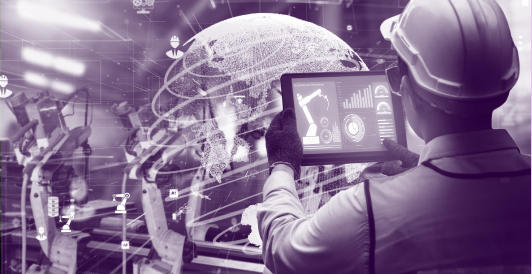Helping Manufacturers Thrive
Manufacturing Industry
If you are a manufacturing executive, you have probably had better years. Inflation is at its highest rate since the 1980s, making it a challenge to control costs. Borrowing is more expensive than many executives can ever remember. And the unprecedented demand for pandemic-driven products—from medical equipment to new golf carts—has waned, as pent-up demand for events, travel, and in-person services have eaten away at consumer spending. All of this has led to caution in the C-suite, with CFOs and COOs being asked to reduce costs and protect profit margins. But in times of unprecedented technological change, some investments are too critical to postpone. Research from McKinsey Company has shown that companies that invest in innovation during the toughest times emerge from the storm stronger, ready to outperform the competition. Manufacturers who invest in tackling the following key challenges will find themselves in a stronger position to boost profits and growth, while lowering costs and increasing margins.
InspireXT has a particular expertise delivering supply chain manufacturing solutions for regulated industries, such as pharma and life sciences – click here for more details

Evolution of the Manufacturing Industry: A Decade of Transformation

2013-2015

Traditional Manufacturing
Era
- Mass production.
- Manual labor dominant.
- Limited automation
2016-2017

Emergence of Industry
4.0 Technologies
- Introduction of advanced technologies.
- Initial steps towards automation.
- Digital transformation begins.
2018-2020

Integration of Digital
Technologies
- Increased integration of digital technologies.
- Data-driven decision-making.
- Focus on efficiency and cost reduction.
Key Trends
2019-2021
2020-2022
2022-2024
2019-2021
Automation and Robotics Revolution
- Advanced automation becomes widespread.
- Robotics revolutionizes manufacturing processes.
- Improved precision and efficiency.
2020-2022
Supply
Chain Resilience
- Emphasis on building resilient supply chains.
- Integration of technologies for transparency early warning.
- Mitigating disruptions through advanced planning.
2022-2024
Customization and
Flexibility
- Shift towards customized manufacturing.
- Flexible production processes.
- Meeting dynamic market demands.
Impact

Economic and Environmental Impact
(2015- now and beyond)
- Economic growth due to efficiency gains.
- Positive environmental impact with sustainable practices.
Conclusion

Future Outlook
(2025 onwards)
- Continued evolution with emerging technologies.
- Focus on sustainability and circular economy principles.
Key Challenges
01
Managing Shortages
and Disruptions
Quick response times are top of mind for chief supply chain officers, who continue to face supply shortages and disruptions. Today’s manufacturers need connected operations and insight to stay nimble, be resilient to change, and spot new revenue-generating opportunities.
02
Navigating Demand Risk and Higher Operating Costs
With demand volatility expected to last well into next year, companies are looking for ways to boost automation and avoid unnecessary costs. But the best decisions need accurate insights. C-suites are looking for easy-to-use dashboards, real-time alerts, built-in AI, and consistent data across HR, finance, and the supply chain.
03
Rising IT costs, Legacy Systems Running On-premises, and Data Silos
Manufacturers cannot realize the promise of Industry 4.0 with ageing, disconnected, legacy technologies. They need to connect operational data—from the factory to the field—with IT systems that can process, analyze, and present the information via charts and graphics that are easy to understand.
04
Ageing Workforce and a Growing Need for Tech-savvy Workers
Manufacturers are struggling to fill open positions as they compete for workers seeking flexible schedules, higher wages, and opportunities for career advancement. They are also competing with technology companies for tech-savvy workers as they automate manufacturing. HR teams must find a way to tap new talent pools to replace workers ageing out of the industry.
05
Adopting Service-based Business Models and Software-driven Products
Services have become an important growth engine, with companies using subscription-based models to offer services along with their products. The benefit to the customer is that they can make fewer capital investments and reduce their debt load. The benefit to the manufacturer is a stable, recurring revenue stream.
06
Creating a Sustainable, Circular Supply Chain
Customers, investors, and governments continue to look closely at corporate environmental practices. From minimizing carbon emissions and energy consumption to safe disposal and reuse of parts, manufacturers and their suppliers must revamp their value chains to be more sustainable.
07
Cost and Complexity of Onboarding Acquired Companies
Mergers and acquisitions will play a key role in driving growth for manufacturing companies. But growth via acquisition comes with integration headaches—whether it is integrating finance systems across subsidiaries or integrating employees into company operations.
How InspireXT addresses these challenges with Manufacturing Services/Solutions
Other Industries
Request for services
Find out more about how we can help your organization navigate its next. Let us know your areas of interest so that we can serve you better.


